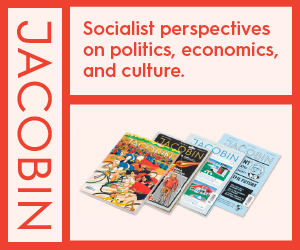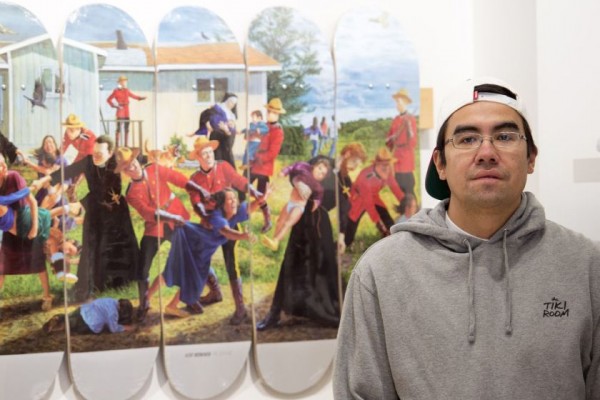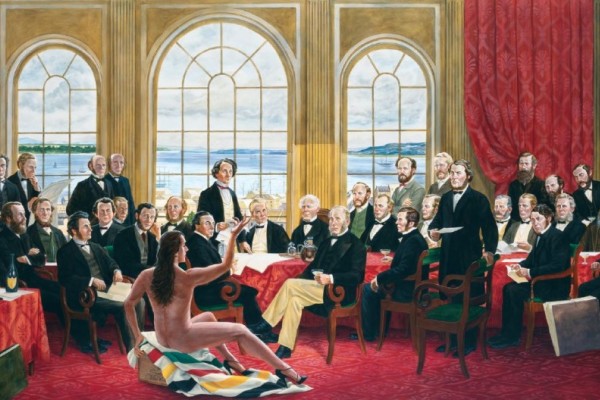Contempo Abo
Two spirit in aboriginal culture

Kent Monkman. The Emergence of a Legend (2). From a series of 5 Chromogenic Prints. 2006.
Noam Gonick spoke on Alert Radio with aboriginal artists Kent Monkman and Adrian Stimson about Two-Spirit in their contemporary art practice. Adrian Stimson is a Blackfoot performance artist living in Saskatoon who works in installation and photography and is well known for his persona “Buffalo Boy” who often appears at the Burning Man festival in Nevada. Toronto-based Kent Monkman plays the role of “Miss Chief Eagle Testicle” in a performance context and is a painter of Cree descent, raised in Winnipeg, who also works in video installation and film. His landscape painting “Triumph of Mischief” appears on the cover of Propagandhi’s latest album, Supporting Caste. Monkman has been invited to participate in the 17th Sydney Biennale of Contemporary Art in 2010.
Noam Gonick How would you define Two-Spirit?
Adrian Stimson In the research I’ve done, the term was coined in Winnipeg by a group of gay-queer-lesbian people who got together in the late-80s/early-90s trying to come up with a better term than the anthropological “Berdache.” It was the idea of two spirits, male and female, within one body. After much deliberation they came up with that term always remembering that within First Nations languages there are terms that were used by various groups.
NG And what was the reaction in various Native circles when this term was invented or reintroduced into the language?
Kent Monkman I think it was readily accepted, people wanted a word that spoke to an Aboriginal queer or lesbian or trans-identity. Because I think, like Adrian said, there are words that exist in Aboriginal languages, but even the terms “Aboriginal” or “Indian,” “Native”—these are all in a European language so often these things fall short when we attempt to define them. There didn’t exist anything of the third gender in European culture, so a gap existed in terms of being able to identify as queer and Aboriginal people.
ng Both of you use magic in regards to the two spirits, showing audiences an alternative way of being and the potential for transformation in your personae when you perform as Miss Chief or Buffalo Boy.
as I would say that medicine has always existed within Aboriginal communities. But of course with the colonial project and Christianity, which influenced nations, medicine really was pushed underground. So the type of magic you’re talking about allows for communities, both Aboriginal and non, to get a glimpse that there are other ways of being and ways of identifying yourselves and through the character Buffalo Boy, I play back and forth between male and female and sometimes you just really don’t know.
ng Right, and Kent, can you talk about your own personal self-discovery through your character, through your art over the past decade? There’s a dialogue between your work and the persona you take on within your work.
km Well, Miss Chief originated first in my paintings. I was really interested in the documentarians of the 19th Century, the Europeans who were looking at Aboriginal cultures. I looked at a number of different artists, and of course the larger body of art history, and I became fascinated with George Catlin because he encountered and wrote about two characters: the Berdache and the Dandy. I was really interested in looking for the evidence of sexual variance, even if it was filtered through a European lens – and looking for evidence that might have been in our history, or in the journals of the European, which of course was always coded in their own biases and so forth. So Miss Chief was created as a way of identifying with the Berdache, as the French referred to the Two-Spirited person. And with that sense of mischief that she’s imbued with, she plays a bit with the spirit of the trickster in my films and artwork. This really underscores a desire to look at history as it was written by Europeans, but to look at it through an Aboriginal lens. And that I think is where a lot of the magic comes from, and a lot of the play.
ng I do see a reversal-of-fortune in the tricksterism that you employ wherein the oppressor, the colonialist who stole Native land is himself raped and pillaged. You’ve reversed history, giving it the flip-flop in a delightful and enjoyable way. You work is imbued with sexuality—we see imagery of the RCMP involved in sexual encounters with Native warriors where they’re getting their uniformed butts spanked and whatnot, and it’s delightful or charming in a way. Are you ever taken to task for eroticizing the genocide of Native people?
km I don’t think I’m eroticizing genocide at all. I think what I’m presenting is an empowered perspective and an empowered way of life, looking at our own sexuality; and yes I’m playing with traditional power relationships and reversing them, but it’s certainly not about sexualizing or making fun of genocide. No one has ever raised that question or issue with me.
as Yeah, I would agree too, that if anything it’s the idea of using one’s voice as a tool for empowerment, and by doing that you bring forth the layers that exists within our common histories, especially as it relates to the genocide. I think if anything it provokes people to actually look further into it and find out for themselves what that history is all about. And through humour and sexuality there’s a way—of course it’s pretty common to us all—and it opens a door and it allows people access to understand it even further.
km There’s actually, if you look at traditional Aboriginal stories, a lot of bawdy humour, a lot of sexual humour. It’s there. It’s part of our culture.
as Absolutely. Just a little story, back home on the reserve they were interviewing a bunch of the elders and older ladies and they were talking casually and the interviewer just couldn’t believe the amount of sexual innuendo. She felt like she was in a boy’s locker room.
ng You both have dealt a lot with gender, race and sexuality in your work, but I always think of bell hooks and her edict that we must all employ gender, race and class to make a full-bodied piece of cultural cooking as it were. Do either of you deal with class in your work, or do you have a class interpretation of the art world you find yourselves within?
as Yeah, I think class is definitely something that is one of the layers within my work, and I think that you can’t help but look at class and especially issues of poverty that face First Nations people. It’s definitely part of my identity and history.
km It’s definitely a layer in my work as well. As soon as you start looking at the history of our people, you will find that societal relationships really shifted over time; Aboriginal people, were met by dignitaries from Canadian society as equals. Treaties and agreements were made with the leaders of our nations. In the late 1800s Louis Riel was leading a republic, which would have become the Republic of Manitoba if things had gone differently. So when I looked at the history of my own family, and I saw how they became dispossessed of their own land and pushed further out into more remote areas. This dispossession of our nations has come over time, but these were people who wanted to participate in society at many different levels. And I think there is a perception that Aboriginal people are largely impoverished, but you just have to look at the history to understand how that happened.
ng You brought up Louis Riel, which always makes me remember his prophecy that in a hundred years time his people would rise up and the artists would lead the way. Do either of you think about that in your work?
as Absolutely. I first heard that quote a number of years ago when I was in politics and I wondered about it then. At that point I didn’t really identify myself as an artist, but it is definitely brought up quite often in various circles. So definitely it’s something that influences. But on a personal level I don’t think that I have any grand delusions that I’m somebody who’s leading that. More like I’m a part of a collective, a group of people, who are doing amazing things and are very progressive—critical thinking and all that stuff around shaping the road for the future.
ng I’ve noticed that you’ve both talked about killing off the personae that you’ve taken on. Kent, I heard from you that this is it, this is the last performance as Miss Chief Eagle Testicle, that she’s not coming out anymore. And Buffalo has staged his death several times.
km Well, I should just qualify that and just say that this is the last performance of Miss Chief at that price range (laughter). She’s getting a little more expensive. But yeah, I kind of fantasize about killing her off in some sort of glamourous or outrageous way, and sort of bring her back again, but you know, she still has a certain place in my work and I don’t think I’m done with her yet.
as Yeah, same here. For me, the whole idea of killing off Buffalo Boy—with death comes celebrity. It’s also ideas and notions of time too, because I think to aboriginal mythology and spirituality our physical being may be gone but our influences carry on. It’s fun playing with that idea of time. Even after death things can be occurring so really I think it becomes more than just the ideas of life and death. It’s about being.
This article appeared in the July/August 2009 issue of Canadian Dimension (The queer issue).










